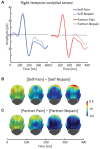Empathy, Pain and Attention: Cues that Predict Pain Stimulation to the Partner and the Self Capture Visual Attention
- PMID: 28979199
- PMCID: PMC5611362
- DOI: 10.3389/fnhum.2017.00465
Empathy, Pain and Attention: Cues that Predict Pain Stimulation to the Partner and the Self Capture Visual Attention
Abstract
Empathy motivates helping and cooperative behaviors and plays an important role in social interactions and personal communication. The present research examined the hypothesis that a state of empathy guides attention towards stimuli significant to others in a similar way as to stimuli relevant to the self. Sixteen couples in romantic partnerships were examined in a pain-related empathy paradigm including an anticipation phase and a stimulation phase. Abstract visual symbols (i.e., arrows and flashes) signaled the delivery of a Pain or Nopain stimulus to the partner or the self while dense sensor event-related potentials (ERPs) were simultaneously recorded from both persons. During the anticipation phase, stimuli predicting Pain compared to Nopain stimuli to the partner elicited a larger early posterior negativity (EPN) and late positive potential (LPP), which were similar in topography and latency to the EPN and LPP modulations elicited by stimuli signaling pain for the self. Noteworthy, using abstract cue symbols to cue Pain and Nopain stimuli suggests that these effects are not driven by perceptual features. The findings demonstrate that symbolic stimuli relevant for the partner capture attention, which implies a state of empathy to the pain of the partner. From a broader perspective, states of empathy appear to regulate attention processing according to the perceived needs and goals of the partner.
Keywords: EPN; LPP; attention; emotion; empathy.
Figures





Similar articles
-
Brain dynamics of visual attention during anticipation and encoding of threat- and safe-cues in spider-phobic individuals.Soc Cogn Affect Neurosci. 2015 Sep;10(9):1177-86. doi: 10.1093/scan/nsv002. Epub 2015 Jan 20. Soc Cogn Affect Neurosci. 2015. PMID: 25608985 Free PMC article.
-
Neural time course of pain observation in infancy.Dev Sci. 2021 Jul;24(4):e13074. doi: 10.1111/desc.13074. Epub 2020 Dec 26. Dev Sci. 2021. PMID: 33314507
-
Empathy for pain influences perceptual and motor processing: Evidence from response force, ERPs, and EEG oscillations.Soc Neurosci. 2017 Dec;12(6):701-716. doi: 10.1080/17470919.2016.1238009. Epub 2016 Sep 28. Soc Neurosci. 2017. PMID: 27643572
-
Cognitive reappraisal of snake and spider pictures: An event-related potentials study.Int J Psychophysiol. 2018 Aug;130:1-8. doi: 10.1016/j.ijpsycho.2018.05.010. Epub 2018 May 30. Int J Psychophysiol. 2018. PMID: 29859220
-
Emotion and the processing of symbolic gestures: an event-related brain potential study.Soc Cogn Affect Neurosci. 2011 Jan;6(1):109-18. doi: 10.1093/scan/nsq022. Epub 2010 Mar 8. Soc Cogn Affect Neurosci. 2011. PMID: 20212003 Free PMC article.
Cited by
-
Sensor Technologies to Manage the Physiological Traits of Chronic Pain: A Review.Sensors (Basel). 2020 Jan 8;20(2):365. doi: 10.3390/s20020365. Sensors (Basel). 2020. PMID: 31936420 Free PMC article. Review.
-
Evaluating the relationship between pain empathy, knowledge and attitudes among nurses in North China: a cross-sectional study.BMC Nurs. 2023 Oct 31;22(1):411. doi: 10.1186/s12912-023-01577-2. BMC Nurs. 2023. PMID: 37907895 Free PMC article.
-
Differences in empathy toward patients between medical and nonmedical students: an fMRI study.Adv Health Sci Educ Theory Pract. 2021 Oct;26(4):1207-1227. doi: 10.1007/s10459-021-10045-y. Epub 2021 Apr 20. Adv Health Sci Educ Theory Pract. 2021. PMID: 33877486 Free PMC article.
-
Behavioral and EEG Measures Show no Amplifying Effects of Shared Attention on Attention or Memory.Sci Rep. 2020 May 21;10(1):8458. doi: 10.1038/s41598-020-65311-7. Sci Rep. 2020. PMID: 32439964 Free PMC article.
-
Linking brain structure and activation in anterior insula cortex to explain the trait empathy for pain.Hum Brain Mapp. 2020 Mar;41(4):1030-1042. doi: 10.1002/hbm.24858. Epub 2019 Nov 5. Hum Brain Mapp. 2020. PMID: 31691467 Free PMC article.
References
-
- Aron A., Aron E. N., Smollan D. (1992). Inclusion of other in the self-scale and the structure of interpersonal closeness. J. Pers. Soc. Psychol. 63, 596–612. 10.1037/0022-3514.63.4.596 - DOI
-
- Bischof-Köhler D. (2012). Empathy and self-recognition in phylogenetic and ontogenetic perspective. Emot. Rev. 4, 40–48. 10.1177/1754073911421377 - DOI
LinkOut - more resources
Full Text Sources
Other Literature Sources

